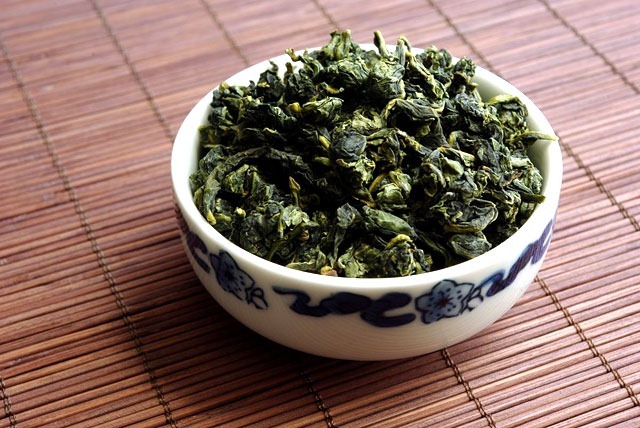
Oolong Tea Tie Guan Yin
Oolong (simplified Chinese: 乌龙; traditional Chinese: 烏龍; pinyin: wūlóng) is a traditional Chinese tea (Camellia sinensis) produced through a unique process including withering under the strong sun and oxidation before curling and twisting. The name oolong tea comes into the English language from the Chinese name (Chinese: 烏龍茶), meaning "black dragon tea".
Possible Origins
There are three widely accepted explanations on how the Chinese name came about. According to the "tribute tea" theory, oolong tea was a direct descendant of Dragon-Phoenix Tea Cake tribute tea. Oolong tea replaced it when loose tea came into fashion. Since it was dark, long and curly, it was called the Black Dragon tea.
According to the "Wuyi" theory, oolong tea first existed in Wuyi Mountain. This is evidenced by Qing dynasty poems such as Wuyi Tea Song (武夷茶歌) and Tea Tale (茶说). It was said that oolong tea was named after the part of Wuyi mountain where it was originally produced.
According to the "Anxi" theory, oolong tea had its origin in the Anxi oolong tea plant. A man named Sulong, Wulong or Wuliang discovered it.
Another tale tells of a man named Wu Liang (later corrupted to Wu Long, or Oolong) who discovered oolong tea by accident when he was distracted by a deer after a hard day's tea-picking, and by the time he remembered about the tea it had already started to oxidise.
In Chinese tea culture, the semi-oxidised teas are collectively grouped as qīng chá (Chinese: 青茶; literally "blue-green tea" or simply "blue tea"). Though the term "blue tea" may sound unfamiliar, Oolong tea is a familiar and well-known name. Oolong tea is another name for blue tea.
Most oolong productions, especially fine quality ones, involved unique tea plant cultivars that are exclusively used for particular varieties. In terms of degree of fermentation, it can range from 8% to 85%,depending on the variety and production style. The popularity of this tea category is closely tied to tea connoisseurs of south China and Chinese expatriates in Southeast Asia,and the tea preparation process that originated from this area: gongfu tea-making, or the gongfu tea infusion approach.
Since oolong tea is semi-oxidised, processed by both green tea and black tea techniques. Oolong tea boasts green tea's fragrance and black tea's taste. Brewing in hot water, the of the green tea leaves turn red, earning it the term"green leaf red edge". More than 300 years' development has led to several kinds of oolong and the unique flavour and taste attract more and more oolong fans.
The taste of oolong ranges hugely amongst various sub-varieties. It can be sweet and fruity with honey aromas, or woody and thick with roasted aromas, or green and fresh with bouquet aromas, all depending on the horticulture and style of production. Several subvarieties of oolong, including those produced in the Wuyi Mountains of northern Fujian and in the central mountains of Taiwan, are among the most famous Chinese teas.


I'm gone to convey my little brother, that he should also go to see this web site on regular basis to get updated from hottest news.|
whoah this blog is magnificent i like reading your posts. Keep up the great work! You know, many persons are searching round for this info, you can help them greatly. |
Hi there! Would you mind if I share your blog with my zynga group? There's a lot of people that I think would really enjoy your content. Please let me know. Many thanks
Hi i am kavin, its my first time to commenting anywhere, when i read this article i thought i could also make comment due to this brilliant paragraph.|
Great work! This is the type of information that should be shared around the web. Shame on Google for not positioning this post higher! Come on over and visit my site . Thanks =)
I am genuinely glad to glance at this blog posts which includes plenty of useful information, thanks for providing these kinds of information.|
Hello there! This blog post could not be written much better! Looking at this article reminds me of my previous roommate! He constantly kept talking about this. I will forward this article to him. Pretty sure he'll have a very good read. Thank you for sharing!|
I always spent my half an hour to read this webpage's articles everyday along with a mug of coffee.|
Its such as you learn my thoughts! You appear to grasp a lot approximately this, like you wrote the e-book in it or something. I think that you can do with some to pressure the message house a little bit, but instead of that, this is great blog. A fantastic read. I will definitely be back.|
This design is wicked! You certainly know how to keep a reader amused. Between your wit and your videos, I was almost moved to start my own blog (well, almost...HaHa!) Wonderful job. I really enjoyed what you had to say, and more than that, how you presented it. Too cool!|